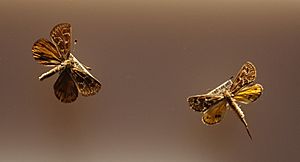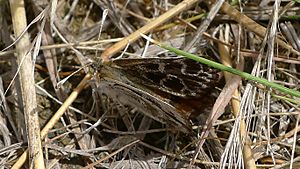Golden sun moth facts for kids
Quick facts for kids Synemon plana |
|
|---|---|
 |
|
| Synemon plana male (left) and female (right) | |
 |
|
| Conservation status | |
| Scientific classification | |
| Kingdom: | |
| Phylum: | |
| Class: | |
| Order: | |
| Family: |
Castniidae
|
| Genus: |
Synemon
|
| Species: |
S. plana
|
| Binomial name | |
| Synemon plana Walker, 1854
|
|
| Synonyms | |
|
|
The golden sun moth, also known as Synemon plana, is a special type of moth that flies during the day. It lives only in Australia. This moth is very unique because it has club-shaped antennae, unlike most other moths that have feathery ones.
About the Golden Sun Moth
The golden sun moth is a medium-sized insect. Its club-shaped antennae are a key feature that helps identify it. Most other moths have brushy or feathery antennae, but not the golden sun moth.
This moth is on the list of critically endangered animals in Australia. This means it is at a very high risk of disappearing forever. The golden sun moth mostly lives in grasslands where certain types of grasses grow. These grasses are called Austrodanthonia species. For the moth to do well, at least 40% of the area should be covered by these specific grasses.
Male golden sun moths are not very colorful. Their front wings are dark brown with pale grey patterns. Their back wings are brown with darker brown patches.
Female golden sun moths are much brighter. Their front wings have brown and grey patterns. Their back wings are a bright golden brown with dark brown patches on the edges. This golden color is how the moth got its common name. Female golden sun moths usually cannot fly well. Their back wings are much smaller compared to the males.
Life cycle
The life cycle of the golden sun moth is quite interesting. Scientists believe these moths live for about two years. However, some studies suggest a new generation might appear every 12 months.
After mating, female moths lay up to 200 eggs. They place these eggs at the bottom of Austrodanthonia grass clumps. The eggs hatch after about 21 days.
The tiny larvae then dig tunnels underground. They stay there, feeding on the roots of the grass. After some time, they dig a vertical tunnel up to the surface. Here, they turn into a pupa. The pupa stays in this tunnel for about six weeks. Then, the adult moths emerge.
When female moths come out as adults, they already have fully developed eggs. They immediately start looking for a mate. They flash their bright orange back wings to attract any males flying nearby. Adult golden sun moths only live for two to five days. This is because they cannot eat once they become adults.
Recent Sightings
In January 2021, a golden sun moth was seen and photographed. A man walking his dog in Wangaratta, Victoria spotted it.



